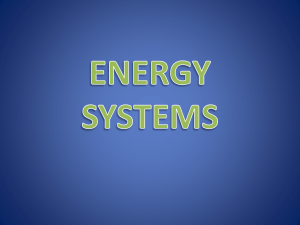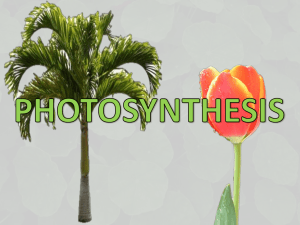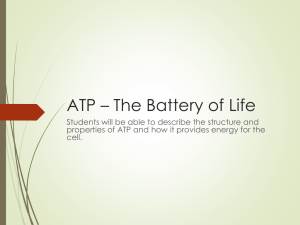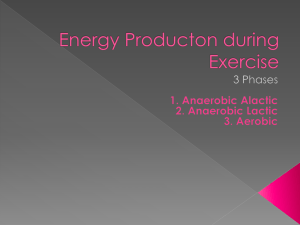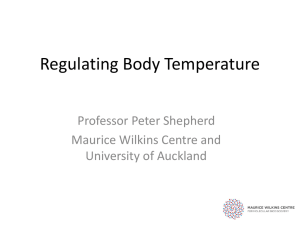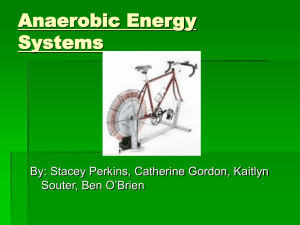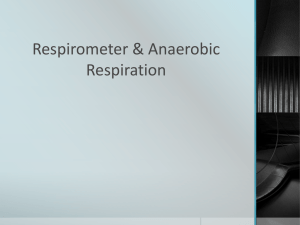Anaerobic Metabolism
advertisement
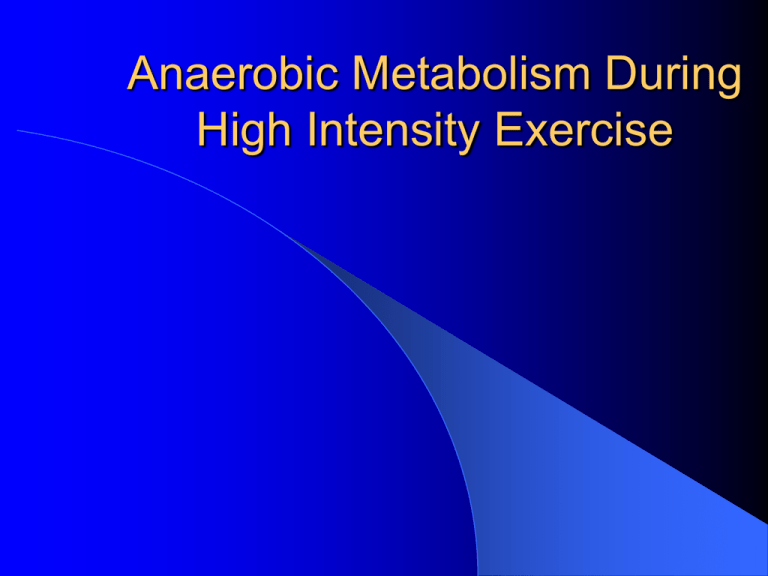
Anaerobic Metabolism During High Intensity Exercise Various Roles for Anaerobic Metabolism Essential when the demand for ATP is greater than can be provided by aerobic metabolism At the onset of high-intensity exercise At maximal O2 consumption The onset of High Intensity Exercise Anaerobically derived ATP may contribute 80-90 % of the total – O2 is in short supply until cardiovascular system can meet demands Near Maximal O2 Uptake Near maximal O2 uptake, increases in workload elicit greater contribution from anaerobic sources – Since aerobic metabolism is maximal, the only other source of ATP is from non-oxidative sources Anaerobic Contribution Decreases as Exercise Progresses 30 s – 80 % anaerobic/20 % aerobic 60-90 s – 45 % anaerobic/55 % aerobic 120-180 s – 30 % anaerobic/70 % aerobic Insert fig 1.2 Insert Fig 1.1 Sources of Anaerobic ATP CP or PCr degradation Endogenous ATP Glycolysis PCr Degradation Creatine PhosphoKinase PCr + ADP + H+ ATP + Cr Glycolysis Glycogen + 3 ADP + H+3 ATP + 2 lactate + 2 H+ – Can use this relationship to determine ATP provision from glycolysis during intense exercise – Take a post exercise muscle biopsy and multiply [La+] by 1.5 Must also take into account lactate that leaves muscle Adenosine Phosphorylation Adenylate Kinase 2 ADP ATP + AMP • creates an ATP, but also leaves an AMP Deamination AMP + H+ IMP + NH4+ AMP Deaminase • Conversion of AMP to IMP is irreversible • Prevents buildup of AMP • in conjunction with Adenylate Kinase prevents accumulation of ADP [ATP]/[ADP] Ratio Important because it determines free energy Hi [ATP]/[ADP] allows ATP to be converted to ADP more easily – If this happens, there is more free energy Lo [ATP]/[ADP] – ATPADP more difficult – Less free energy How do you keep the ratio high? Keep making ATP from ADP Also, Adenylate Kinase – ADP + ADP ATP + AMP – But AMP can go back to ADP So Deamination converts ADP to IMP and removes loitering ADPs Adenylate Kinase and AMP deaminase work together to prevent AMP and ADP buildup Why do we want to keep ratio high? To maintain control of energy flow We must generate ATP, but if ADP or AMP accumulate we lose control of metabolism Timing of Anaerobic Pathways Traditional “Serial Metabolism” PCr degradation immediate and only source of ATP supply in first 10 s When PCr depleted glycolysis begins No overlap of two pathways Recent evidence argues against this PCr Degradation PCr degradation is indeed instantaneous Biopsies after 1.28 s of electrical stimulation show PCr breakdown Glycolysis Also Instantaneous Elevated [La+] reported after 10 s cycling 110 % VO2max Although no resting sample taken (Saltin et al., Jacobs et al.) Other studies have shown [La+] after only 6 s, and PCr stores were not depleted after 6 or 10 s Rates of Anaerobic Metabolism Anaerobic ATP must be provided at very high rate Power outputs of 2-4 times VO2max can be attained for short periods Even though anaerobic pathways provide less ATP per mole of substrate than oxidative pathways Insert Table 1.2 Rate Continued 0-10 s - ~6.0 – 9.0 mmol ATP/kg dm/s – Combined for PCr and glycolysis 30 s – PCr ~ 1.6 and glycolysis ~4.4 mmol/kg dm/s – Assuming 25 % releas of lactate, ~5.8 for glycolysis Insert fig 1.4 Take Home Highest rates of ATP provision from PCr and glycolysis 0-10 s From 10 – 30 s PCr stores are depleted – Glycolytic rate ~ 50 % of intitial 10 s – Glycolytic rate of ATP provision during 30s maximal exercise, 3-4 times > PCr Direct Measurement of Anaerobic ATP Provision Insert Table 1.3 Problems Associated with Measuring Anaerobic ATP Provision Must take pre and post-exercise biopsies Must account for lactate release from muscle – Arterial and venous blood sampling – If not, exhaustive exercise or…. – Spriet et al. and closed circulation Glycolysis During intense exercise bouts ~3 min, glycolysis provides ~ 80 % total anaerobic ATP Glycolysis is activated more quickly than aerobic metabolism – provides ATP at a higher rate Can provide more ATP than PCr degradation Glucose from where? Glucose can come from blood or glycogen During short-intense exercise, primarily from glycogen Uptake of glucose cannot meet glycolytic demand GLUT proteins Regulation Accumulation of G-6-P inhibits glucose phosphorlation Primary points of regulation are PHOS and PFK Why does G-6-P inhibit glucose phosphorylation? Low level of glycolytic flux – Glycolysis isn’t moving very fast – Must not need G-6-P That glucose can be stored as glycogen instead of being utilized for glycolysis PHOS regulation PHOS = glycogen phosphorylase The enzyme responsible for breakdown of glycogen to glucose Removes one glucose at a time by adding Pi (phosphorylating) Insert fig 12.2 from Houston PHOS cont’d Km of PHOS for glycogen very low (1-2 mM) – Means that PHOS has high affinity for glycogen This means PHOS can function effectively even at low glycogen concentrations More PHOS Previous exercise can affect glycogenolytic rate relative to glycogen concentration For example during afternoon practice following morning practice.. – If glycogen stores are low, glycogenolysis will be reduced – Higher glycogen stores will result in higher relative glycogenolysis Insert fig 1.5 Pi and PHOS regulation Phosphorylation of PHOS (pretty redundant eh?) results in conversion of forms – b is inactive form – a is active form – Phosphorylation converts b form to a Implications for activity??? At rest 10-20% of PHOS in a form Conversion from b to a doesn’t necessarily mean increased glycogenolysis Free Pi also needs to be available for elevated glycogenolysis to occur Calcium activates PHOS kinase Phosphorylation of PHOS (again) results from PHOS kinase PHOS kinase activated by elevations in intracellular [Ca2+] Why would you want to tie PHOS to intracellular [Ca 2+]?? With E/C coupling Ca2+ released from sarcoplasmic reticulum Intracellular [Ca2+] elevated drastically and rapidly Therefore glycogenolysis is tied closely to muscular contraction Acidosis hinders PHOS acitivity Conversion of PHOS b to a is depressed under acidic conditions After repeated bouts of interval cycling, decreased activation of glycogenolysis related to increasing muscle acidity (Spriet et al.) Although activity was still reduced in a second bout 1 hour after the first, where H+ had recovered Phosphofructokinase (PFK) regulation Most important regulator of PFK activity is ATP ATP can bind to PFK at two sites and alter its activity Binds to catalytic site with high affinity Can also bind to allosteric site PFK cont’d Binding to the allosteric site inhibits activity So,… when [ATP] in the cell is high, PFK will be inhibited – no need for glycolysis, plenty of ATP H+ can enhance ATP affinity for allosteric site – Provides feedback inhibition Some other proposed modulators Inhibitors – Citrate – Phosphoglycerate – Phophoenolpyruvate – Mg2+ Promoters – AMP and ADP – Pi – NH4+ – Fructose –2,6 diphosphate Citrate Probably not a major factor during short, intense exercise Aerobic metabolism does not contribute greatly until later (>30 s) Citrate probably does not accumulate within the 30-60 s time frame Promoters ADP and AMP will accumulate rapidly at the onset of anaerobic exercise – Breakdown of PCr H+ may be reduced at the onset of exercise – Removing the ATP induced inhibition Conclusion PFK regulation is obviously a complicated matter During exercise many of the promoters (ADP,AMP, Pi, and NH4+) will accumulate ATP will be reduced, but H+ should also rise There may be unidentified factros which help maintain the awkward balance of promotion and inhibition during intense exercise
